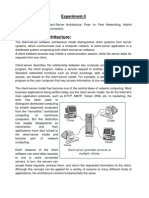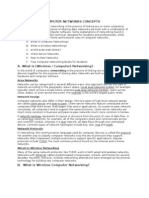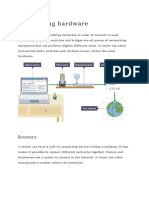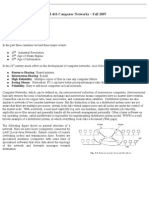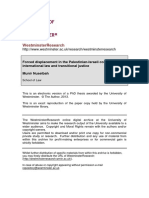PROGRAMME DIPLOMA IN ELECTRONIC ENGINEERING (COMMUNICATION)
COURSE
DEP50033: DATA COMMUNICATION AND NETWORKING.
CODE
TITLE COMPUTER NETWORK FUNDAMENTAL USING PACKET TRACER
SOFTWARE (LAB 4)
LECTURER
PUAN. FAZIDA BT ADLAN
NAME
NAME MATRIC NUMBER
SASITHAREN A/L SANGKAR 08DEP17F2010
1
�TABLE OF CONTENTS
NO CONTENT
1.0 TITLE
2.0 OBJECTIVE
3.0 APPARATUS
4.0 THEORY
4.1 CLIENT SERVER NETWORKS
4.2 INTRODUCTION TO PEER TO PEER NETWORKS
4.3 PACKET TRACER SOFTWARE
5.0 PROCEDURE
6.0 RESULTS
7.0 DISCUSSION
8.0 CONCLUSION
9.0 REFERENCE
2
�1.0 TITLE: COMPUTER NETWORK FUNDAMENTAL USING PACKET TRACER
SOFTWARE.
2.0 OBJECTIVE:
i. Understand Client/server and P2P network setup and device.
ii. Identify the type of cables, computer setting and IP setting for each network.
iii. Construct a networks using appropraite apparatus in the software.
iv. To test the ability if the network to share and send data.
v. Measure and compare the RTT (Round Trip Time) using PING Utility Test.
vi. Describe the correlation between type, behaviour and abilities of each networks.
3.0 APPARATUS:
i. Desktop
ii. Packet tracer software
3
�4.0 THEORY
In the world of computers, networking is the practice of linking two or more computing devices
together for the purpose of sharing data. Networks are built with a mix of computer hardware
and computer software. Area Networks Networks can be categorized in several different ways.
One approach defines the type of network according to the geographic area it spans. Local area
networks (LANs), for example, typically reach across a single home, whereas wide area
networks (WANs), reach across cities, states, or even across the world. The Internet is the
world's largest public WAN. Network Design Computer networks also differ in their design.
The two types of high-level network design are called client-server and peer-to-peer. Client-
server networks feature centralized server computers that store email, Web pages, files and or
applications. On a peer-to-peer network, conversely, all computers tend to support the same
functions. Client-server networks are much more common in business and peer-to-peer
networks much more common in homes. A network topology represents its layout or structure
from the point of view of data flow. In so-called bus networks, for example, all of the computers
share and communicate across one common conduit, whereas in a star network, all data flows
through one centralized device. Common types of network topologies include bus, star, ring
and mesh. Network Protocols In networking, the communication language used by computer
devices is called the protocol. Yet another way to classify computer networks is by the set of
protocols they support. Networks often implement multiple protocols to support specific
applications. Popular protocols include TCP/IP, the most common protocol found on the
Internet and in home networks. Wired vs Wireless Networking Many of the same network
protocols, like TCP/IP, work in both wired and wireless networks. Networks with Ethernet
cables predominated in businesses, schools, and homes for several decades. Recently, however,
wireless networking alternatives have emerged as the premier technology for building new
computer networks.
4.1 CLIENT SERVER NETWORKS
The term client-server refers to a popular model for computer networking that utilizes client
and server devices each designed for specific purposes. The client-server model can be used
on the Internet as well as local area networks (LANs). Examples of client-server systems on
the Internet include Web browsers and Web servers, FTP clients and servers, and DNS. Client
and Server Devices Client/server networking grew in popularity many years ago as personal
computers (PCs) became the common alternative to older mainframe computers. Client devices
are typically PCs with network software applications installed that request and receive
information over the network. Mobile devices as well as desktop computers can both function
as clients. A server device typically stores files and databases including more complex
applications like Web sites. Server devices often feature higher-powered central processors,
more memory, and larger disk drives than clients. Client-Server Applications The client-server
model distinguishes between applications as well as devices. Network clients make requests to
a server by sending messages, and servers respond to their clients by acting on each request
and returning results. One server generally supports numerous clients, and multiple servers can
4
�be networked together in a pool to handle the increased processing load as the number of clients
grows. A client computer and a server computer are usually two separate devices, each
customized for their designed purpose. For example, a Web client works best with a large
screen display, while a Web server does not need any display at all and can be located anywhere
in the world. However, in some cases a given device can function both as a client and a server
for the same application. Likewise, a device that is a server for one application can
simultaneously act as a client to other servers, for different applications. [Some of the most
popular applications on the Internet follow the client-server model including email, FTP and
Web services. Each of these clients features a user interface (either graphic- or text-based) and
a client application that allows the user to connect to servers. In the case of email and FTP,
users enter a computer name (or sometimes an IP address) into the interface to set up
connections to the server. Local Client-Server Networks Many home networks utilize client-
server systems without even realizing it. Broadband routers, for example, contain DHCP
servers that provide IP addresses to the home computers (DHCP clients). Other types of
network servers found in home include print servers and backup servers. Client-Server vs Peer-
to-Peer and Other Models The client-server model was originally developed to allow more
users to share access to database applications. Compared to the mainframe approach, client-
server offers improved scalability because connections can be made as needed rather than being
fixed. The clientserver model also supports modular applications that can make the job of
creating software easier. In so-called "two-tier" and "three-tier" types of client-server systems,
software applications are separated into modular pieces, and each piece is installed on clients
or servers specialized for that subsystem. Client-server is just one approach to managing
network applications The primary alternative, peer-to-peer networking, models all devices as
having equivalent capability rather than specialized client or server roles. Compared to client-
server, peer to peer networks offer some advantages such as more flexibility in growing the
system to handle large number of clients. Client-server networks generally offer advantages in
keeping data secure.
4.2 INTRODUCTION TO PEER TO PEER NETWORKS
Peer to peer is an approach to computer networking where all computers share equivalent
responsibility for processing data. Peer-to-peer networking (also known simply as peer networking)
differs from client-server networking, where certain devices have responsibility for providing or
"serving" data and other devices consume or otherwise act as "clients" of those servers.
Characteristics of a Peer Network Peer to peer networking is common on small local area networks
(LANs), particularly home networks. Both wired and wireless home networks can be configured as
peer to peer environments. Computers in a peer to peer network run the same networking protocols
and software. Peer networks are also often situated physically near to each other, typically in homes,
small businesses or schools. Some peer networks, however, utilize the Internet and are geographically
dispersed worldwide. Home networks that utilize broadband routers are hybrid peer to peer and
client-server environments. The router provides centralized Internet connection sharing, but file,
printer and other resource sharing is managed directly between the local computers involved. Peer to
Peer and P2P Networks Internet-based peer to peer networks emerged in the 1990s due to the
development of P2P file sharing networks like Napster. Technically, many P2P networks (including the
original Napster) are not pure peer networks but rather hybrid designs as they utilize central servers
for some functions such as search. Peer to Peer and Ad Hoc Wi-Fi Networks Wi-Fi wireless networks
5
�support so-called ad hoc connections between devices. Ad hoc Wi-Fi networks are pure peer to peer
compared to those utilizing wireless routers as an intermediate device. Benefits of a Peer to Peer
Network You can configure computers in peer to peer workgroups to allow sharing of files, printers
and other resources across all the devices. Peer networks allow data to be shared easily in both
directions, whether for downloads to your computer or uploads from your computer. On the Internet,
peer to peer networks handle a very high volume of file sharing traffic by distributing the load across
many computers. Because they do not rely exclusively on central servers, P2P networks both scales
better and are more resilient than client-server networks in case of failures or traffic bottlenecks [1].
4.3 PACKET TRACER SOFTWARE
is a cross-platform visual simulation tool designed by Cisco Systems that allows users to
create network topologies and imitate modern computer networks. The software allows users
to simulate the configuration of Cisco routers and switches using a simulated command line
interface. Packet Tracer makes use of a drag and drop user interface, allowing users to add and
remove simulated network devices as they see fit. Packet Tracer allows students to design
complex and large networks, which is often not feasible with physical hardware, due to costs.
Packet Tracer is commonly used by CCNA Academy students, since it is available to them for
free. However, due to functional limitations, it is intended by CISCO to be used only as a
learning aid, not a replacement for Cisco routers and switches. The application itself only has
a small number of features found within the actual hardware running a current Cisco
IOS version. Thus, Packet Tracer is unsuitable for modelling production networks. It has a
limited command set, meaning it is not possible to practice all of the IOS commands that might
be required. Packet Tracer can be useful for understanding abstract networking concepts, such
as the Enhanced Interior Gateway Routing Protocol by animating these elements in a visual
form. Packet Tracer is also useful in education by providing additional components, including
an authoring system, network protocol simulation and improving knowledge an assessment
system[2].
5.0 PROCEDURE
1) Packet tracer software was opened in our desktop.
2) End devices icon was clicked at the lower left corner.
Figure 1: End device icon
6
�3) Computer icon was selected and two computer icons were dropped at worsheet.
Figure 2: PC0 and PC1 at worksheets
4) Connections icon was clicked and automatically choose connection type was clicked.
Figure 3: Connection icon
5) Clicked PC0 then PC1.
Figure 4: PC0 and PC1 connected
7
�6) PC0 double clicked.
7) Desktop tab, then clicked IP configuration.
8) IP Address for Subnet Mask have been set up.
Figure 5: IP address of PC0
9) IP address for PC1 was assigned same steps as for PC0 but IP address will be (198.168.2.2).
Figure 6: IP address of PC1
10) Command prompt in desktop tab for PC0 was opened.
11) “ping 192.168.2.1” was enetered in command prompt.
8
� Figure 7: Command prompt
12) Connection between PC0 and PC1 was successful.
6.0 RESULT
Figure 8: Simulation succesful data has been tranfred.
7.0 DISCUSSION
In this lab, we learn on computer network fundamental using packet tracer. Network is a group
of two or more computer systems or other devices that are linked together to exchange data.
First of all we opened the packet tracer software. We clicked the left end corner icon devices
in the software and placed a PC icon at the worksheet. Next, we clicked connections icon and
choose the automatically connection type. This is to connect the two PC’s. We clicked the PC0
icon in worksheet, choose desktop tab and in ip configuration area we go to the IP address were
we assigned IP address of “192.168.2.1” for PC0 and for PC1 same method which the IP
address of “192.168.2.2” was assigned for PC1. After done assingning we go to command
9
�prompt and enter ping 198.168.2.1 at PC0. Command Prompt is a command line interpreter
application available in most Windows operating systems. It's used to execute entered
commands. Most of those commands automate tasks via scripts and batch files, perform
advanced administrative functions, and troubleshoot or solve certain kinds of Windows issues.
The command was succefully executed. Ping statistics for 192.168.2.1:
Packets: Sent = 4, Received = 4, Lost = 0 (0% loss).
Approximate round trip times in milli-seconds: Minimum = 3ms, Maximum = 16ms, Average =
6ms
8.0 CONCLUSION
At end of this lab, we understood about client/server and P2P network setup and device. Next,
we also identified the type of cables, computer setting and IP setting for each network. An IP
address is a unique number assigned to every device connected to a network that uses the
Internet Protocol for communication. Each IP address identifies the device’s host network and
the location of the device on the host network. When one device sends data to another, the data
includes a ‘header’ that includes the IP address of the sending device and the IP address of the
destination device. Moreover, we constructed a networks using appropraite apparatus in the
software. We used packet tracer software in this lab. Other than that, we also tested the ability
if the network to share and send data. We also measured and compare the RTT (Round Trip
Time) using PING Utility Test. RTT is typically measured using a ping — a command-line
tool that bounces a request off a server and calculates the time taken to reach a user device.
There are some factors which influence RTT. For eaxmple, Distance. The length a signal has
to travel correlates with the time taken for a request to reach a server and a response to reach a
browser. Next, transmission medium, is the medium used to route a signal. Example, copper
wire, fiber optic cables. This can impact how quickly a request is received by a server and
routed back to a user. Finally, we described the correlation between type, behaviour and
abilities of each networks.
9.0 REFERENCE
[1] https://www.scribd.com/doc/38212875/Fundamental-Computer-Networks-Concepts
[2] https://en.wikipedia.org/wiki/Packet_Tracer
[3] https://www.lifewire.com/command-prompt-2625840
[4] https://www.imperva.com/learn/performance/round-trip-time-rtt/
10










